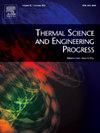基于湿乙醇燃料HCCI发动机的高效三联产系统,用于发电、供热和制冷:热力学评估
IF 5.1
3区 工程技术
Q2 ENERGY & FUELS
引用次数: 0
摘要
在本研究中,对湿式乙醇燃料HCCI发动机驱动的三联产系统进行了比较热力学评估,目标是以环境可持续的方式满足各种消费者需求的能源需求(电力、供暖和制冷)。通过Kalina循环利用HCCI发动机的废热,以及基于NH3-H2O的吸收式制冷循环(ARC)和废热交换器(WHE),可以同时发电、制冷和供热。为了检验系统的性能,对该模型进行了基于能量和火用平衡的综合热力学研究。此外,还进行了参数调查,以评估一些重要的不同设计参数如何影响所提出的三联发系统的有用输出和性能。研究结果表明,在不利用余热(即没有触底循环)的情况下,HCCI发动机的能量效率和火用效率分别为41.59%和34.29%。然而,通过整合Kalina循环、ARC循环和WHE,有效利用湿式乙醇燃料HCCI发动机的余热,系统整体能量效率和火用效率分别显著提高到51.49%和39.28%。此外,在额定运行条件下,三联发电系统的电力效率为44.64%,加热效率为4.94%,冷却效率为1.91%。此外,研究还确定了该三联产系统中关键的火用破坏部件为HCCI发动机、催化转化器、HRVG和冷凝器1,其火用耗散分别为58.51%、12.16%、8.76%和6.12%。本文章由计算机程序翻译,如有差异,请以英文原文为准。

An efficient trigeneration system based on a wet-ethanol fuelled HCCI engine for the production of power, heating, and cooling: Thermodynamic assessment
In this study, a comparative thermodynamic assessment was conducted for a trigeneration system driven by a wet-ethanol fueled HCCI engine, with the goal of meeting the energy needs (electricity, heating, and cooling) for various consumer demands in an environmentally sustainable manner. Utilizing the waste heat from HCCI engines through the Kalina cycle alongside the NH3-H2O based Absorption refrigeration cycle (ARC) and waste heat exchanger (WHE) makes it possible to produce power, cooling, and provide heating simultaneously. To examine the system performance, a comprehensive thermodynamic investigation based on energy and exergy balances are applied to this model. Additionally, a parametric investigation is also carried out to assess how some important different design parameters influence the useful outputs and performance of the proposed trigeneration system. The findings indicate that the HCCI engine achieved energy and exergy efficiencies of 41.59% and 34.29%, respectively, when waste heat was not utilized (i.e., without a bottoming cycle). However, with the effective use of waste heat from a wet-ethanol fuelled HCCI engine through the integration of the Kalina cycle, ARC cycle, and WHE, the overall system energy and exergy efficiencies were significantly enhanced to 51.49% and 39.28%, respectively. Additionally, the trigeneration system attains energy efficiencies of 44.64% for electricity, 4.94% for heating, and 1.91% for cooling under nominal operating conditions. Furthermore, the study identifies the key exergy destructive components within the proposed trigeneration system are the HCCI engine, catalytic converter, HRVG, and condenser 1, which exhibit exergy dissipation of 58.51%, 12.16%, 8.76%, and 6.12% respectively.
求助全文
通过发布文献求助,成功后即可免费获取论文全文。
去求助
来源期刊

Thermal Science and Engineering Progress
Chemical Engineering-Fluid Flow and Transfer Processes
CiteScore
7.20
自引率
10.40%
发文量
327
审稿时长
41 days
期刊介绍:
Thermal Science and Engineering Progress (TSEP) publishes original, high-quality research articles that span activities ranging from fundamental scientific research and discussion of the more controversial thermodynamic theories, to developments in thermal engineering that are in many instances examples of the way scientists and engineers are addressing the challenges facing a growing population – smart cities and global warming – maximising thermodynamic efficiencies and minimising all heat losses. It is intended that these will be of current relevance and interest to industry, academia and other practitioners. It is evident that many specialised journals in thermal and, to some extent, in fluid disciplines tend to focus on topics that can be classified as fundamental in nature, or are ‘applied’ and near-market. Thermal Science and Engineering Progress will bridge the gap between these two areas, allowing authors to make an easy choice, should they or a journal editor feel that their papers are ‘out of scope’ when considering other journals. The range of topics covered by Thermal Science and Engineering Progress addresses the rapid rate of development being made in thermal transfer processes as they affect traditional fields, and important growth in the topical research areas of aerospace, thermal biological and medical systems, electronics and nano-technologies, renewable energy systems, food production (including agriculture), and the need to minimise man-made thermal impacts on climate change. Review articles on appropriate topics for TSEP are encouraged, although until TSEP is fully established, these will be limited in number. Before submitting such articles, please contact one of the Editors, or a member of the Editorial Advisory Board with an outline of your proposal and your expertise in the area of your review.
 求助内容:
求助内容: 应助结果提醒方式:
应助结果提醒方式:


